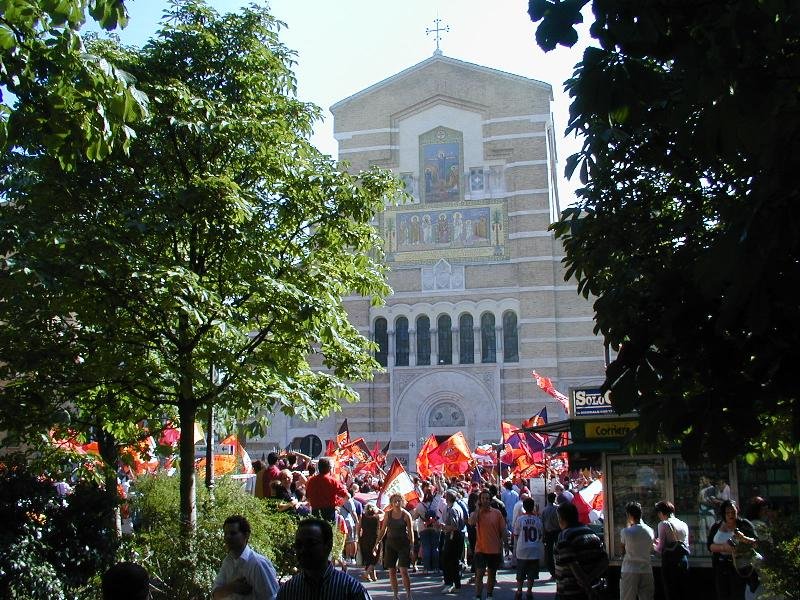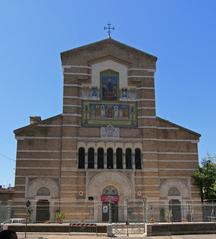
Visiting Santa Maria Liberatrice, Rome: Complete Guide, Tickets, Hours & Tips
Date: 15/06/2025
Introduction
Santa Maria Liberatrice in Rome stands as a vivid testament to the city’s enduring Christian heritage, architectural evolution, and community spirit. With origins tracing back to the 6th-century Santa Maria Antiqua in the Roman Forum, the church’s story is one of resilience and renewal, culminating in its 20th-century rebirth in the lively Testaccio district. Today, it serves not just as a religious landmark but also as a vibrant social and cultural hub, particularly under the stewardship of the Salesian order.
This comprehensive guide delves into the church’s fascinating history, architectural and artistic highlights, religious and social significance, visitor information—including hours, tickets, and accessibility—and offers practical tips to enrich your visit. Whether you’re a history enthusiast, a pilgrim, or simply curious about Rome’s hidden gems, Santa Maria Liberatrice offers a unique window into the city’s living heritage.
For further details, consult resources such as Turismo Roma, Artepiù, and Rome Art Lover.
Table of Contents
- Introduction
- Historical Overview
- Religious and Cultural Significance
- Notable Figures and Events
- Visitor Information
- Architectural and Artistic Highlights
- Community and Social Role
- Visiting Tips and FAQs
- Conclusion & Recommendations
- References
Historical Overview
Origins and Early History
Santa Maria Liberatrice traces its ancestry to Santa Maria Antiqua, established in the 6th century within the Roman Forum. This early sanctuary, built into remnants of Emperor Domitian’s palace, was renowned for its precious Byzantine frescoes (The History Blog; White Rose eTheses). After an earthquake in 847 AD caused its abandonment, a new church—Santa Maria Liberatrice al Foro Romano—was erected atop its ruins in the 13th century. The title “Liberatrice” (Liberator) evokes the Virgin Mary’s protective role, rooted in legends such as Pope Sylvester I’s defeat of a dragon, symbolizing deliverance from evil (Roman Churches Wiki; Corvinus).
Medieval and Baroque Transformations
Initially serving a Benedictine convent, the church underwent Baroque transformations in the 17th and 18th centuries—most notably with a remodel by Onorio Longhi in 1617 and lavish interior decoration by Francesco Ferrari and others in 1749 (Roman Churches Wiki). The church was an integral part of the Forum’s spiritual landscape until the turn of the 20th century.
Demolition and the Birth of Santa Maria Liberatrice in Testaccio
In the early 1900s, the church in the Forum was demolished to facilitate archaeological excavations of Santa Maria Antiqua’s frescoes (Corvinus). To preserve the community’s devotion, a new church—Santa Maria Liberatrice a Testaccio—was constructed between 1906 and 1908 in the burgeoning Testaccio district. Architect Mario Ceradini designed the church in Romanesque Revival style, incorporating mosaics and motifs inspired by its ancient predecessor (Artepiù; Wikipedia IT).
Religious and Cultural Significance
Santa Maria Liberatrice is deeply embedded in Rome’s Marian tradition. The church inherited the venerated “Sancta Maria libera nos a poenis inferni” icon—symbolizing liberation and protection—which was transferred from the Forum to Testaccio (Artepiù). Today, it remains a focal point for annual feasts and local devotion, drawing pilgrims and parishioners alike.
The church’s administration by the Salesian order ensures a vibrant liturgical and social calendar, with a particular emphasis on youth education, outreach, and fostering community spirit (Salesiani Don Bosco).
Notable Figures and Events
- Pope Leo XIII: Initiated the relocation and rebuilding of the church.
- Pope Pius X: Commissioned the new church and reinforced its community mission.
- Mario Ceradini: Architect who blended historical references with modern needs.
- Luigi Maria Olivares: First parish priest and later recognized as Venerable (Wikipedia IT).
Key events include the church’s consecration in 1908 and its elevation to titular church status in 1965 (Wikipedia EN). The annual Festa Patronale di Santa Maria Liberatrice, held in late May or early June, features processions, floral tributes, and lively celebrations (Testaccina).
Visitor Information
Hours, Tickets & Accessibility
- General Hours: Daily, 8:00 AM – 12:00 PM & 4:00 PM – 7:00 PM (may vary for religious holidays or special events).
- Sunday & Holidays: 9:00 AM – 12:30 PM & 5:00 PM – 7:00 PM (aligns with Mass times).
- Admission: Free. Donations for maintenance and community activities are welcome.
- Accessibility: Step-free entry and accessible restrooms via the adjacent P.Stop. Assistance available during opening hours.
Directions & Getting There
- Address: Piazza di Santa Maria Liberatrice, Testaccio, Rome.
- Metro: Piramide (Line B), 10-minute walk.
- Tram & Bus: Tram lines 3 and 8; Bus lines 23, 30, 75, 280, 716 (stop at Marmorata/Vanvitelli).
- By Car: Limited local parking; public transport is recommended.
Visitor Amenities
- P.Stop Information Point: Offers free Wi-Fi, tourist information, accessible toilets, water dispensers, family restrooms, and Roma Pass ticket services (Turismo Roma).
- Restrooms: Accessible facilities available at P.Stop for a small fee.
Nearby Attractions
- Testaccio Market: A culinary and cultural hub.
- Pyramid of Cestius: Ancient Roman tomb.
- Museo MACRO Testaccio: Contemporary art exhibitions.
- Monte dei Cocci: Historic mound of ancient pottery shards.
- Non-Catholic Cemetery: Final resting place of poets Keats and Shelley (Civilisable).
Architectural and Artistic Highlights
Santa Maria Liberatrice is a prime example of neo-Romanesque architecture, featuring a harmonious brick façade, symmetrical arches, and a rose window. The entrance mosaic is a reproduction of the original Santa Maria Antiqua fresco. The interior boasts:
- Apse Mosaic: Madonna and Child, surrounded by saints and angels, rendered in vibrant tesserae.
- Marble Flooring: Black and white geometric patterns interspersed with zodiac signs, symbolizing the months and Christ’s birth.
- Stained Glass: Scenes from the Virgin’s life and Salesian history.
- Columns & Capitals: Carved with foliage, biblical scenes, and medieval motifs (Artepiù).
The church’s nave and chapels are bathed in natural light, creating an atmosphere conducive to reflection and prayer.
Community and Social Role
Santa Maria Liberatrice is more than a place of worship—it’s a community anchor. The parish hall and facilities host youth programs, catechism, and charitable outreach. The Salesians’ focus on education and youth engagement is evident in sports, music, and cultural events organized for local children and teens. The church’s feast day and other festivals foster strong neighborhood bonds (Comune di Roma).
During the 2025 Jubilee, the church is set to play an expanded role, offering special liturgies and welcoming pilgrims (Visit Italy).
Visiting Tips and FAQs
Dress Code: Modest attire; shoulders and knees should be covered.
Photography: Discreet photos allowed; avoid flash and photography during services.
Best Time to Visit: Mornings for quiet reflection, or during the annual festival for a cultural experience.
Guided Tours: Occasional tours via local organizations; check parish website or Turismo Roma.
Roma Pass: Purchase or collect at the P.Stop for discounts on public transport and museums.
FAQ:
-
Q: What are the visiting hours?
A: Daily, 8:00–12:00 and 16:00–19:00; Sundays and holidays align with Mass times. -
Q: Is there an entrance fee?
A: No, entry is free. -
Q: Is it wheelchair accessible?
A: Yes, including accessible restrooms via P.Stop. -
Q: Can I attend Mass?
A: Yes, Mass times are posted at the entrance and on the parish website. -
Q: Are guided tours available?
A: Occasionally via local guides; inquire ahead. -
Q: When is the best time to visit?
A: For tranquility, visit in the morning; for festivity, attend the Festa Patronale in late May/early June.
Conclusion & Recommendations
Santa Maria Liberatrice embodies Rome’s profound continuity of faith, artistry, and community. Its journey from the ancient Forum to Testaccio is reflected in its mosaics, architecture, and the living traditions celebrated by its parishioners. As you explore its luminous nave and vibrant piazza, you’ll discover a church that serves as both a sanctuary and a community cornerstone.
Visitor recommendations:
- Plan your visit during the annual festival for an authentic Roman experience.
- Combine your visit with a stroll through Testaccio’s market and eateries.
- Use the P.Stop for practical amenities and local advice.
- Download the Audiala app for audio guides and up-to-date information.
As Rome prepares for the 2025 Jubilee, Santa Maria Liberatrice stands ready to welcome visitors and pilgrims to experience its unique blend of history, devotion, and living culture.
References
- Artepiù – Santa Maria Liberatrice Mosaics
- Rome Art Lover – Santa Maria Liberatrice
- Turismo Roma – Santa Maria Liberatrice
- Roman Churches Wiki – Santa Maria Liberatrice
- Visit Italy – Jubilee 2025 in Rome
- Testaccina – Festa Patronale
- Civilisable – Testaccio Neighborhood
- P.Stop Services


















































































































































































































































